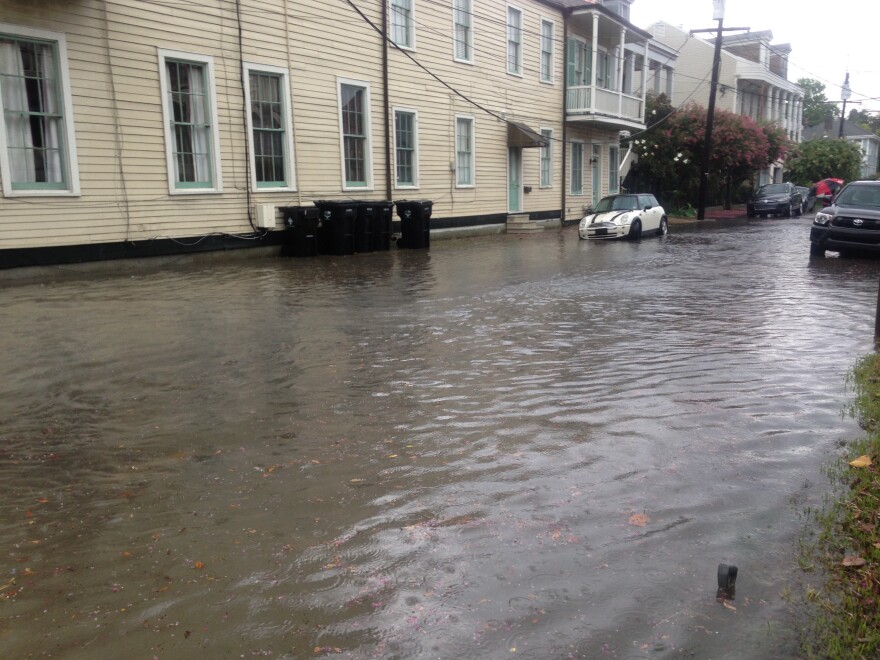Scientists say climate change will bring heavier rains and more intense storms. City officials have acknowledged that New Orleans needs to rethink how it deals with rain — by reducing reliance on mechanical pumps and managing the water where it falls.
Thanks to a post-Katrina settlement with FEMA, the city has more than $2 billion to fix streets and drainage — a perfect opportunity to try some new ideas. But will it?
Last August, a massive thunderstorm hovered over New Orleans. It sat, and sat, and sat — ultimately dumping more than 8 inches of rain on some parts of the city.
The streets are an essential aspect of the New Orleans drainage system. When it rains, that’s where most of the water ends up. It washes off private property, into catch basins, down drainage canals, and is eventually pumped into Lake Pontchartrain.
The Sewerage and Water Board’s drainage system couldn’t keep up on Aug. 5. Several pieces of important equipment were indeed broken — drainage pumps as well as generators that power those pumps — it was also a freak storm. But scientists say those kinds of storms are going to become more common.

The city deals with rainwater pretty much the way it has for more than 100 years: pump it out as fast as possible. Lately, people have been rethinking that approach. The Greater New Orleans Urban Water Plan, for example, imagines how the city could use so-called "green infrastructure" to reduce the amount of water draining into the streets.
Andy Sternad is an architect with Waggonner and Ball. He helped write the Urban Water Plan.
"Fundamentally, we're trying to change the way water is managed in the city," he says, "from pump first to pump only when necessary. We want to slow down water in the landscape and store it — every place we possibly can."
Examples include roads with porous pavement that allow water to seep through, and rain gardens, which are specially designed to absorb water.
The city now has access to a big, new pot of money for infrastructure repairs in town: more than $2 billion dollars in settlement money from FEMA, due to damages from Hurricane Katrina.
After the storm, FEMA inspected everything — sewer lines, drainage canals, water pipes, streets. The city and FEMA negotiated the $2 billion dollars after the assessments were complete. The first of those projects are just starting.
It's not clear how many of those projects include green infrastructure. Architect Andy Sternad inspected one FEMA-funded road project, a stretch along Robert E. Lee Blvd., in Gentilly.

"Basically what they've done is torn up the existing concrete and are just pouring new concrete in exactly the same place," he says.
In other words, it'll be fixed. But Sternad says he doesn't see any signs that it'll be "green."
"This project is not showing any sign of green infrastructure," says Sternad. "This is pretty standard street repair."
Despite all the talk about rain gardens and permeable pavement, the city is still building streets the conventional way.
Ramsey Green oversees infrastructure projects for the city. He says there are strict rules about how FEMA money can be used. The city signed an agreement.
Despite all the talk about rain gardens and permeable pavement, the city is still building streets the conventional way.
“I mean it is a long document that has all these specific things that we have to do,” says Green. “We can't go back and change it. I mean it's just one of those things we just can't do.”
The money the city got from FEMA was meant to build things back to the way they were before Katrina.
“I can't be like, suddenly, ‘OK, I want permeable pavement on something that's already under construction or in design,’” he says.
Green says there might be some flexibility with FEMA-funded projects that haven’t been designed yet, and the city will look into whether it can work some green infrastructure into those.

"I think perhaps we could make some modest changes to that program. In my conversations with FEMA, that's a big change."
Green agrees that the city can't keep dealing with drainage the old-fashioned way.
"That's not healthy, that our citizens look outside and a deep rainfall starts, and they get nervous. We should live in a place that can handle a rain storm," he says. "And we're looking at every avenue to make that work."
Time will tell whether there’s any green infrastructure on those avenues.
This series is a collaboration with The Lens. Support for the Coastal Desk comes from the Walton Family Foundation, the Greater New Orleans Foundation and the Foundation for Louisiana.






